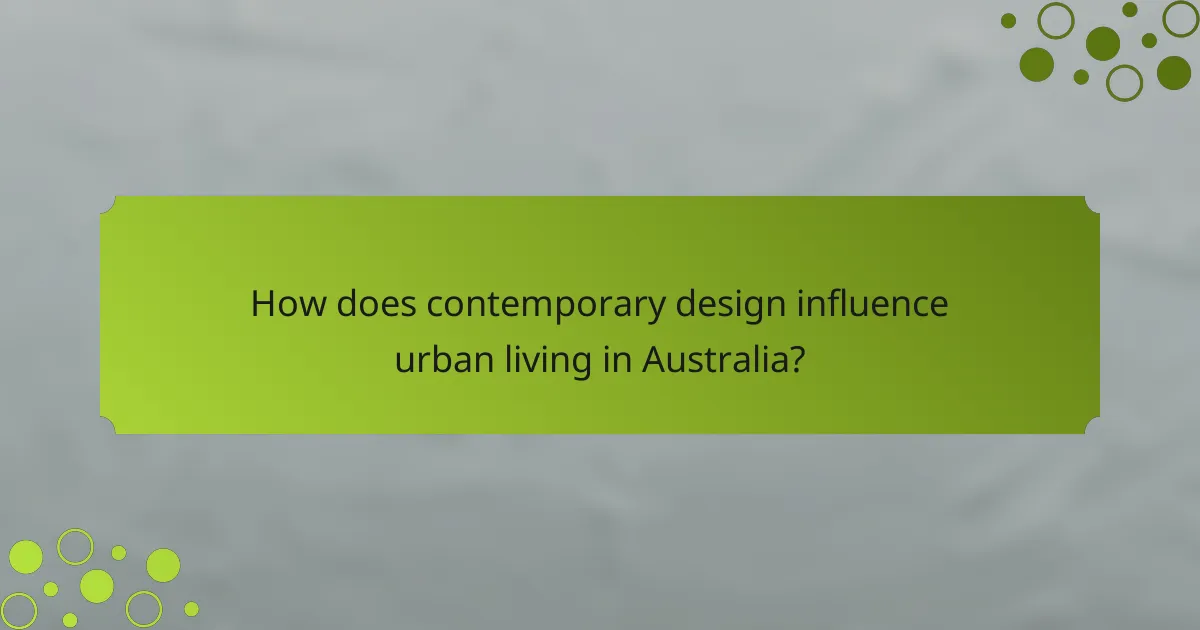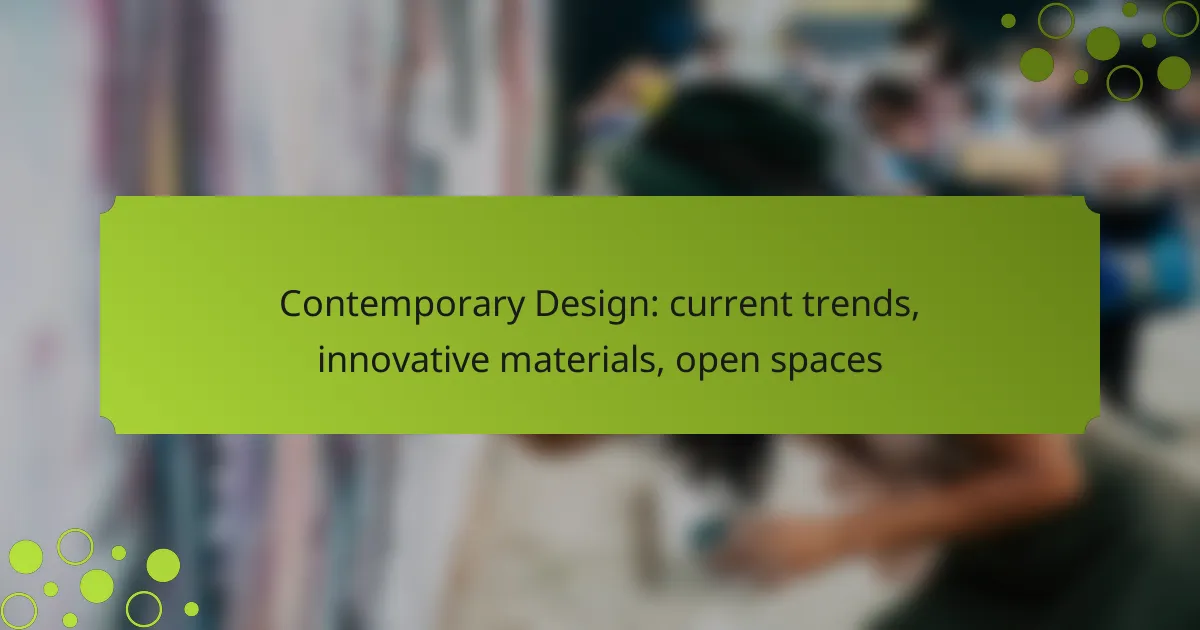Contemporary design embraces a blend of sustainability, functionality, and aesthetic appeal, reflecting modern lifestyles through trends like biophilic design and minimalism. Innovative materials are at the forefront, enhancing both performance and environmental responsibility in architecture and interiors. Additionally, open spaces play a crucial role in fostering community and flexibility, creating inviting environments that enhance user experience.

What are the current trends in contemporary design in Australia?
Contemporary design in Australia is characterized by a focus on sustainability, functionality, and aesthetic appeal. Key trends include biophilic design, minimalism, smart home integration, bold colors and patterns, and adaptive reuse of spaces, all reflecting a modern lifestyle that values both innovation and environmental responsibility.
Biophilic design
Biophilic design emphasizes the connection between nature and the built environment, promoting well-being and productivity. This approach often incorporates natural elements like plants, water features, and natural light into living and working spaces. In Australia, integrating local flora and fauna into design can enhance the aesthetic while supporting biodiversity.
Consider using indoor plants, large windows, and natural materials like timber and stone to create a calming atmosphere. This trend not only improves air quality but also fosters a sense of tranquility and connection to the outdoors.
Minimalism
Minimalism focuses on simplicity and functionality, often characterized by clean lines, neutral colors, and uncluttered spaces. This design philosophy encourages the use of fewer, high-quality items, promoting a sense of calm and order. In Australian homes, minimalism can be achieved through open floor plans and multifunctional furniture.
To embrace minimalism, consider decluttering your space and investing in versatile pieces that serve multiple purposes. This approach not only enhances aesthetics but also makes maintenance easier and more efficient.
Smart home integration
Smart home integration involves incorporating technology into design to enhance convenience and efficiency. This trend includes automated lighting, heating, and security systems that can be controlled remotely. In Australia, smart home technology is becoming increasingly popular, with many homeowners seeking to improve energy efficiency and security.
When designing a smart home, prioritize systems that are user-friendly and compatible with existing devices. Consider energy-efficient appliances and smart thermostats to reduce energy consumption while maintaining comfort.
Bold colors and patterns
Bold colors and patterns are making a statement in contemporary Australian design, adding personality and vibrancy to spaces. This trend encourages the use of bright hues, geometric patterns, and unique textures to create visually stimulating environments. Accent walls and statement furniture pieces are popular ways to incorporate this trend.
To effectively use bold colors, consider creating a focal point in a room while keeping other elements more subdued. This balance allows for a lively atmosphere without overwhelming the space.
Adaptive reuse of spaces
Adaptive reuse involves repurposing existing buildings for new functions, promoting sustainability and preserving cultural heritage. In Australia, this trend is prevalent in urban areas where older structures are transformed into modern living spaces, offices, or community hubs. This approach reduces waste and minimizes the need for new construction.
When considering adaptive reuse, assess the structural integrity and historical significance of the building. Collaborating with architects experienced in this area can help ensure that the transformation respects the original character while meeting contemporary needs.

How are innovative materials shaping contemporary design?
Innovative materials are revolutionizing contemporary design by enhancing functionality, sustainability, and aesthetics. These materials not only improve the performance of structures but also align with environmental goals, making them essential in modern architecture and interior design.
Sustainable materials
Sustainable materials are sourced from renewable resources and designed to minimize environmental impact. Examples include bamboo, cork, and reclaimed wood, which offer durability while reducing carbon footprints. Designers often prioritize these materials to create eco-friendly spaces that appeal to environmentally conscious consumers.
When selecting sustainable materials, consider certifications such as FSC (Forest Stewardship Council) or Cradle to Cradle, which ensure responsible sourcing and production practices. This not only enhances the appeal of a design but also meets growing consumer demand for sustainability.
Smart materials
Smart materials respond dynamically to environmental changes, enhancing user experience and energy efficiency. For instance, thermochromic materials change color with temperature fluctuations, while shape-memory alloys can adapt their form based on heat. These materials are increasingly used in innovative building designs and smart home technologies.
Incorporating smart materials can lead to significant energy savings and improved comfort. However, they often come at a higher cost, so it’s essential to weigh the long-term benefits against initial investments.
Recycled composites
Recycled composites combine waste materials with new substances to create strong, lightweight alternatives for construction and design. Common examples include recycled plastic lumber and concrete made with reclaimed aggregates. These composites not only reduce landfill waste but also offer unique aesthetic qualities.
When using recycled composites, check for certifications that verify their content and performance. This ensures that the materials meet safety standards while contributing to a circular economy.
3D-printed elements
3D printing allows for the creation of complex shapes and structures that traditional manufacturing methods cannot achieve. This technology uses materials like plastic, metal, and even concrete to produce customized components on demand. It significantly reduces waste and can lower production costs for unique designs.
Consider the scalability of 3D printing for your projects. While it is ideal for prototyping and small runs, larger applications may require traditional methods. Always evaluate the material properties to ensure they meet the specific needs of your design.

What role do open spaces play in modern design?
Open spaces are essential in modern design as they enhance functionality, foster community, and create an inviting atmosphere. These areas allow for flexibility in use and can significantly improve the overall experience of a space.
Enhancing natural light
Open spaces maximize the flow of natural light, which can improve mood and productivity. Large windows, skylights, and open floor plans are common features that allow sunlight to penetrate deeper into interiors.
Incorporating reflective surfaces and light-colored materials can further amplify this effect, creating a bright and airy environment. Consider using glass partitions instead of solid walls to maintain openness while still defining areas.
Promoting social interaction
Open spaces encourage social interaction by providing communal areas where people can gather. This design approach fosters collaboration and connection, essential in both residential and commercial settings.
Design elements such as shared seating, communal tables, and open kitchens can facilitate conversations and relationships. When planning these spaces, ensure they are accessible and comfortable to invite engagement.
Improving air quality
Open spaces can enhance air quality by promoting ventilation and reducing indoor pollutants. Natural airflow is crucial, and designs that incorporate operable windows and cross-ventilation can significantly improve the indoor environment.
Additionally, integrating indoor plants can help purify the air and create a more pleasant atmosphere. Consider using low-VOC materials to further minimize harmful emissions in open areas.
Flexible layouts
Flexible layouts are a hallmark of modern design, allowing spaces to adapt to various needs. Open floor plans can be reconfigured for different activities, making them ideal for both work and leisure.
Using movable furniture and modular components can enhance this flexibility. When designing, consider how spaces can be easily transformed to accommodate gatherings, meetings, or quiet time, ensuring they serve multiple purposes effectively.

What are the criteria for selecting contemporary design elements?
When selecting contemporary design elements, prioritize functionality, aesthetic appeal, and environmental impact. These criteria ensure that the design is not only visually pleasing but also practical and sustainable.
Functionality
Functionality is crucial in contemporary design as it emphasizes usability and efficiency. Elements should serve a clear purpose, enhancing the user experience without unnecessary complexity. For instance, multi-functional furniture, like a sofa bed, maximizes space in smaller living areas.
Consider how each design element interacts with the space and its intended use. A well-designed kitchen should facilitate cooking and socializing, with layouts that promote ease of movement and accessibility.
Aesthetic appeal
Aesthetic appeal involves the visual aspects of design that attract and engage users. Contemporary design often features clean lines, minimalism, and a cohesive color palette that creates a harmonious environment. For example, using neutral tones with bold accents can create a striking yet balanced look.
Incorporating artwork or unique textures can elevate the overall aesthetic. Choose pieces that resonate with the intended atmosphere, whether it’s a calming retreat or a vibrant gathering space.
Environmental impact
Environmental impact is increasingly important in contemporary design, focusing on sustainability and resource efficiency. Selecting materials that are eco-friendly, such as reclaimed wood or recycled metals, can significantly reduce a project’s carbon footprint. Additionally, energy-efficient appliances and fixtures contribute to long-term sustainability.
Consider local regulations and certifications, such as LEED or BREEAM, which guide sustainable building practices. These standards can help ensure that your design not only looks good but also supports a healthier planet.

How does contemporary design influence urban living in Australia?
Contemporary design significantly shapes urban living in Australia by promoting functional spaces that foster community interaction and sustainability. This approach emphasizes open layouts, innovative materials, and a strong connection to the environment, enhancing the quality of life for residents.
Creating community spaces
Contemporary design prioritizes the development of community spaces that encourage social interaction and collaboration. Parks, plazas, and shared facilities are integrated into urban layouts, making them accessible and inviting for residents. These spaces often feature seating, greenery, and art installations, fostering a sense of belonging.
For example, many Australian cities are incorporating multifunctional areas that host events, markets, and recreational activities, enhancing community engagement. When designing these spaces, consider factors like visibility, accessibility, and comfort to ensure they meet the needs of diverse populations.
Encouraging walkability
Walkability is a key principle in contemporary urban design, promoting healthier lifestyles and reducing reliance on vehicles. Australian cities are increasingly focusing on pedestrian-friendly infrastructure, such as wide sidewalks, safe crossings, and well-placed amenities. This encourages residents to walk rather than drive, contributing to lower carbon emissions.
To enhance walkability, urban planners should consider mixed-use developments that combine residential, commercial, and recreational spaces within close proximity. This not only supports local businesses but also creates vibrant neighborhoods where people can easily navigate on foot.
Integrating nature into urban areas
Integrating nature into urban environments is a hallmark of contemporary design, enhancing both aesthetic appeal and environmental sustainability. Green roofs, vertical gardens, and urban forests are increasingly common in Australian cities, providing essential green spaces that improve air quality and biodiversity.
Designers should aim to create seamless transitions between built environments and natural landscapes. Incorporating native plants and sustainable materials can help maintain local ecosystems while offering residents a connection to nature, which is vital for mental well-being. Consideration of water management and habitat preservation is also crucial in these designs.
